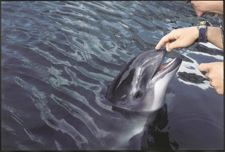Porpoise
2008/9 Schools Wikipedia Selection. Related subjects: Mammals
| Porpoises Fossil range: Mid Miocene to Recent |
||||||||||
|---|---|---|---|---|---|---|---|---|---|---|
 Phocoena phocoena, Harbour Porpoise at the Fjord & Bæltcentret in Denmark
|
||||||||||
| Scientific classification | ||||||||||
|
||||||||||
| Genera | ||||||||||
|
Neophocaena - Finless porpoise |
Porpoises are small cetaceans of the family Phocoenidae; they are related to whales and dolphins. They are distinct from dolphins, although the word "porpoise" has been used to refer to any small dolphin, especially by sailors and fishermen. The most obvious visible difference between the two groups is that porpoises have flattened, spade-shaped teeth distinct from the conical teeth of dolphins.
The name derives from French pourpois, originally from Medieval Latin porcopiscus (porcus pig + piscus fish).
Porpoises, divided into six species, live in all oceans, mostly near the shore. Probably best known is the Harbour Porpoise, which can be found across the Northern Hemisphere.
Taxonomy and evolution
Porpoises, along with whales and dolphins, are descendants of land-living mammals and are related to hoofed animals that first entered the oceans around 50 million years ago. Fossil evidence suggests that porpoises diverged from dolphins and other cetaceans aroud 15 million years ago, during the Miocene. The oldest fossils are known from the shallow seas around the north Pacific, with animals spreading to the European coasts and southern hemisphere only much later, during the Pliocene.
- Sub-order Odontoceti: toothed whales
- Family Phocoenidae: Porpoises
- Genus Neophocaena
- Finless Porpoise, Neophocaena phocaeniodes
- Genus Phocoena
- Harbour Porpoise, Phocoena phocoena
- Vaquita, Phocoena sinus
- Spectacled Porpoise, Phocoena dioptrica
- Burmeister's Porpoise, Phocoena spinipinnis
- Genus Phocoenoides
- Dall's Porpoise, Phocoenoides dalli
- Genus Neophocaena
- Family Phocoenidae: Porpoises
Recently-discovered hybrids between male Harbour porpoises and female Dall's Porpoises indicate that the two species may actually be members of the same genus.
Physical characteristics
Porpoises tend to be smaller but stouter than dolphins. They have small, rounded heads and blunt jaws instead of beaks. While dolphins have a round, bulbous " melon", porpoises do not. Their teeth are spade-shaped, whereas dolphins have conical teeth. In addition, a porpoise's dorsal fin is generally triangular, rather than curved like that of many dolphins and large whales. Some species have small bumps, known as tubercles, on the leading edge of the dorsal fin. The function of these bumps is unknown.
These animals are the smallest cetaceans, reaching body lengths up to 2.5 metres (8 ft); the smallest species is the Vaquita, reaching up to 1.5 m (5 ft). In terms of weight the lightest is the Finless Porpoise at 30-45 kilograms (65-100 lb) and the heaviest is Dall's Porpoise at 130-200 kg (280-440 lb). Because of their small size, porpoises lose body heat to the water more rapidly than other cetaceans. Their stout shape, which minimizes surface area, may be an adaptation to reduce heat loss. Thick blubber also insulates them from the cold. The small size of porpoises requires them to eat frequently, rather than depending on fat reserves.
Life history
Porpoises are relatively r-selected compared with dolphins: that is, they rear young more quickly than dolphins. Female Dall's and Harbour Porpoises often become pregnant with a single calf each year, and pregnancy lasts for about 11 months. Although the lifespan of most species is not known, specimens older than in their mid-teens have rarely been found.
Behaviour
Porpoises are predators of fish, squid, and crustaceans. Although they are capable of dives up to 200 m, they generally hunt in shallow coastal waters. They are found most commonly in small groups of fewer than ten individuals. Rarely, some species form brief aggregations of several hundred animals. Like all toothed whales they are capable of echolocation for finding prey and group coordination. Porpoises are fast swimmers— Dall's porpoise is said to be one of the fastest cetaceans, with a speed of 55 km/h (34 mph). Porpoises tend to be less acrobatic and more wary than dolphins.
Human impact
Accidental entanglement ( bycatch) in fishing nets is the main threat to porpoises today. One of the most endangered cetacean species is the Vaquita, having a limited distribution in the Gulf of California, a highly industrialized area.
In some countries, porpoises are hunted for food or bait meat.
Porpoises are rarely held in captivity in zoos or oceanaria, as they are generally not as capable of adapting to tank life nor as easily trained as dolphins.
In popular culture
In the 1966 Batman film, Batman and Robin are rescued by a "Noble Porpoise" who intercepted a torpedo that was headed in their direction.
In the BBC comedy series, Blackadder The Third, the Prince Regent, played by Hugh Laurie, confuses the title of the story The Prince And The Pauper with The Prince And The Porpoise.
Referred to in the song Barracuda by the band Heart.
In The Illuminatus! Trilogy porpoises are highly advanced sea beings that have a culture spawning tens of thousands of years. They are quite likeable and adept at poetry, through which they preserve accounts of the history of Spaceship Earth. The porpoises help Hagbard Celine and the Discordians in their fight against the Illuminati.
Referred to in a song by Red Hot Chili Peppers.
In Stephen Colbert's spoof animated serial ' Tek Jansen' (aired as part of The Colbert Report), Tek is seen to have a 'zany' porpoise sidekick named Porpy in the extended title sequence.

